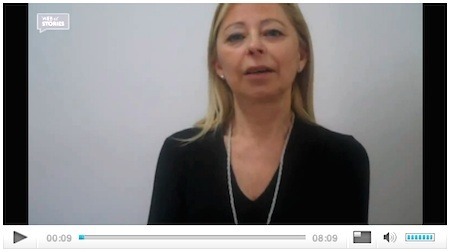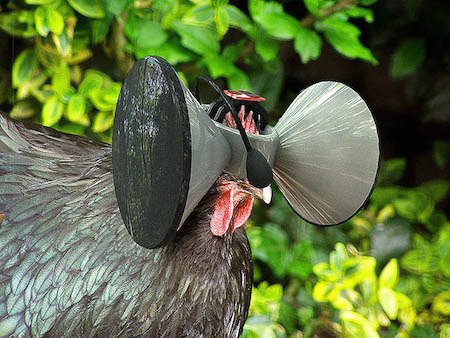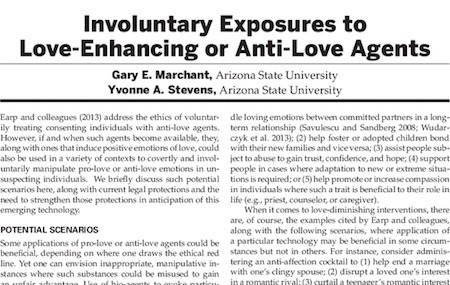Marc Abrahams's Blog, page 401
May 23, 2014
The biochemistry of love: an interview with Ig winner Donatella Marazziti
The Faculty of 1000 blog interviews Ig Nobel Prize winner Donatella Marazitti:
The biochemistry of love: an interview with Donatella Marazziti
By Samuel Winthrop
21 May 2014
Donatella Marazziti is a professor of psychiatry and the director of the psychopharmacology laboratory at the Department of Psychiatry, Neurobiology, Pharmacology and Biotechnology at the University of Pisa. She is also a member of the Mood Disorders section at F1000Prime.
Professor Marazziti recently visited us in our New York City offices and gave us a video interview about her research interests, which involves the study of social relationships. Her team’s research into the biochemistry behind romantic love and its similarities with obsessive-compulsive disorder earned them an Ig Nobel prize in Chemistry in 2000.
As well as her current research, Professor Marazziti tells us how she started in the field of psychiatry, what it was like to be able to be part of ‘the second revolution’ in psychiatry in the 1980s, and what advice she would give to anyone starting out in science, which (bringing us full circle) is to love whatever area one chooses to study.

May 22, 2014
Limerick evaluation of Hitachi’s jokester robot
Limerick laureate Martin Eiger evaluates a technology news item (“Hitachi Unveils Robot With a Sense of Humour“—AFP):
Hitachi’s new robot is shrewd.
It tells its own jokes, they conclude.
I’m a little bit vexed
About what they’ll make next.
If it writes its own limericks, I’m screwed.

Fridge magnet research update – ”Why the fridge?”
 Improbable recently drew attention to the field of Fridge Magnet Research. For those who wish to further investigate the ethnographical aspects of fridge magnets, may we also recommend a study by Dr. Laurel Swan (previously at Brunel University, now a research fellow at the Royal College of Art, UK) and Alex Taylor of Microsoft Research Cambridge Lab, UK.
Improbable recently drew attention to the field of Fridge Magnet Research. For those who wish to further investigate the ethnographical aspects of fridge magnets, may we also recommend a study by Dr. Laurel Swan (previously at Brunel University, now a research fellow at the Royal College of Art, UK) and Alex Taylor of Microsoft Research Cambridge Lab, UK.
‘Notes on Fridge Surfaces’ (in: Proceedings CHI 2005) In which the researchers ask (and then give an answer to) the simple yet crucial question : “Why the fridge?”
“[...] one is compelled to ask, why the fridge? Yes, the fridge offers a relatively large surface available to all and, yes, its surfaces provide a space for the haphazard arrangement of multi-functioning and ever changing items, but still, why the fridge? There are bulletin boards, doors or even walls that can be equally expansive and allow for things to be affixed to them using thumbtacks or tape. Missing in these surfaces is, of course, a magnetic quality. It is this that allows fridge surfaces, with their handy counterparts, magnets, to be inordinately easy to interact with.”
BONUS [1] Neo Teng Yi (of the Mechatronics Engineering dept. at Universiti Tunku Abdul Rahman, Malaysia) and his experimental investigations into the possibilities of constructing perpetual motion (free energy) devices using fridge magnets. ‘Investigation on Free Energy Magnet Motors’
BONUS [2] : Are unsightly refrigerator magnets driving you crazy? Why not get a magnet-removing kitten from Seacliffe Siberians?

May 21, 2014
Water into the magnet, by Ig Nobel (and Nobel) winner Geim
Sarah Lewis profiles Ig Nobel Prize winner, and later also Nobel Prize winner, Andre Geim, in her new book and in Slate:
The Deliberate Amateur
How outlandish experimentation and “grazing shallow” led to a Nobel Prize win.
…Geim became curious about magnetism when he didn’t have the equipment to continue his experiments while working at Radboud University Nijmegen’s High Field Magnet Laboratory in the Netherlands. So one Friday evening he set the electromagnet to maximum power, then poured water straight into the expensive machine. He still can’t remember why he “behaved so unprofessionally,’” but he was able to see how descending water “got stuck” within the vertical bore. Balls of water started floating. They were levitating. He had discovered that a seemingly “feeble magnetic response of water” could act against Earth’s gravitational force….
[Later, on a different subject] …The team submitted a paper summarizing their findings to Nature. The journal rejected it twice—which is such a common fate for historically path-breaking ideas that it could signal an unintended compliment. One referee said it did “not constitute a sufficient scientific advance,” Geim later said in his Nobel Prize acceptance speech….
BONUS: Video of the frog-levitation experiment, which arose from the pouring-the-water-into-the-magnet experiment and which was later honored with an Ig Nobel Prize in physics:
and a demonstration of the graphine experiment, which was later honored with a Nobel Prize in physics:

The introductory physics of being pissed off
Excerpt from an interview with physicist Melissa Franklin, in the Harvard Gazette (with a photo by Stephanie Mitchell:
A: … I didn’t go to class as often as they would have liked, so the headmaster called me in and told me I had to have a goal. He had spoken to my teachers and they thought I should do English literature. Really, just to piss them off, I did physics.
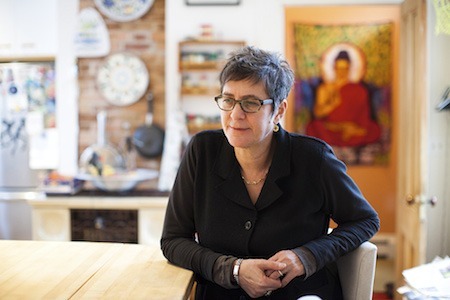
Q: Did you choose physics because it was the opposite of literature or was there some interest left over from that first physics class?
A: I read things I find on bookshelves and I had read a few of the more popular books by the men who created quantum mechanics. So it was an intellectual interest, but I think it also was just the anti-authority part of me. It was hard because it was a two-year program and I was getting into it at Christmastime of the second year.
Q: How did you manage that? You must have had a lot of catching up to do.
A: I didn’t manage it very well. I had a great teacher, but I was pretty terrible. A week before the A level exams, which the whole country takes, they give you a mock exam. And I got 4 percent. At that point, I realized I had to study. It was spring and it was very beautiful out and somehow I got into a mode of studying that was completely intense. So for 10 days, I just studied. I did pass, but I also got really excited about physics. Then I decided I wanted to go to the University of Toronto and study physics. It was a little hard getting into the university, so I had to use the skills I had obtained at the free school to be able to convince people. I went down 34 days in a row and spoke with different people trying to convince them that I was exactly the student they wanted, that I knew exactly what I wanted to do, and eventually they let me in.
Q: At this point, you’re 16?
A: I am 16. The funny thing is, I don’t really know how I finally got in. I suspect it was someone in the Physics Department….

Austin Stewart dreams of drawing art from science
Artist Austin Stewart is one of the more photographically adept of the many artists who concoct arty-sciencey blendings. Here are two of his projects, with Stewart’s words and pictures:
Second Livestock is a virtual reality world for conventionally farmed chickens. Under the guise of providing a solution to maintain the profitability of conventional chicken farming while allowing the chickens to be “free range,” Second Livestock engages the ethical debates of contemporary animal husbandry and humanity’s increasing immersion into virtual worlds.
In a bustling city center a woman rounds a corner with her eyes fixed on the sidewalk a few feet ahead of her…. Covering her face is a gas mask with wheatgrass growing where the filter should be. With each breath the grass absorbs some of the toxins in the air around her and she inhales some freshly generated oxygen.
(Thanks to Ig Nobel Prize winner Brad Bushman for bringing this to our attention.)
BONUS: Chicken, Chicken, Chicken

Wild Mice Utilize a Wheel of Fortuitous Apparation
Wheels sometimes do crop up in nature, especially when a human placed them there. Humans recently did it again, as this report makes clear:
“Wheel Running in the Wild,” Johanna H. (“Joke”) Meijer [pictured here] and Yuri Robbers, Proceedings of the Royal Society B, vol. 281 no. 1786, July 7, 2014. The authors, at Leiden University Medical Centre, The Netherlands, report:
Wheel running is often used in the laboratory for triggering enhanced activity levels, despite the common objection that this behaviour is an artefact of captivity and merely signifies neurosis or stereotypy. If wheel running is indeed caused by captive housing, wild mice are not expected to use a running wheel in nature. This however, to our knowledge, has never been tested. Here, we show that when running wheels are placed in nature, they are frequently used by wild mice, also when no extrinsic reward is provided…. This finding falsifies one criterion for stereotypic behaviour, and suggests that running wheel activity is an elective behaviour…. Our findings may help alleviate the main concern regarding the use of running wheels in research on exercise….
“Various animals use the running wheels, though mice are by far the most common. A breakdown by species is given in Various animals use the running wheels, though mice are by far the most common. A breakdown by species is given in (a). Please note that the vertical axis has been broken in order to accommodate the mice, which accounted for 88% of the wheel running. Also note that birds visited the recording equipment occasionally, but never ran in wheels. Species were identified using video recordings. Stills taken from these recordings show examples of (b) a mouse, (c) a frog and (d ) a slug using the wheel.”
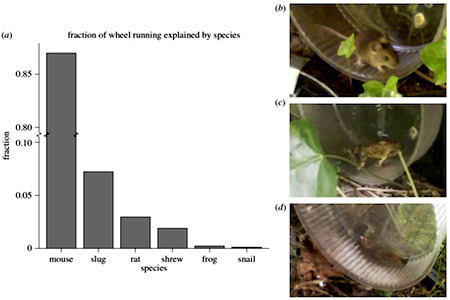
Emily Underwood, writing for Science Now, supplies further details about the report and the researchers. Sarah Zielinsky appraises it for Science News.
BONUS: The Effectiveness of Slug-Throwing

Acoustical delight: The sound of coffee roasting
Many scientists having probed the smell of coffee, one, at least, is probing its sound. He has published a study about it:
“Coffee Roasting Acoustics,” Preston S. Wilson [pictured here], Journal of the Acoustical Society of America, vol. 135, no. 6, 2014. (Thanks to investigator Daniela Müller for bringing this to our attention.) The author, at the University of Texas at Austin, reports:
Cracking sounds emitted by coffee beans during the roasting process were recorded and analyzed… Near the end of the roasting process, sounds known as “first crack” exhibit a higher acoustic amplitude than sounds emitted later, known as ‘second crack’….
“[The] sounds known as first crack and second crack are the result of pyrolytic processes that occur within the bean during roasting. First crack occurs at an internal bean temperature of approximately 200 °C and coincides with the release of steam and gases. Each bean experiences a first crack, and hence as a group of beans is roasting, first one or two cracks are heard and then more and more occur forming a chorus of first cracks. After about two minutes, first crack ceases and there is an acoustically inactive time. Second crack occurs when the temperature reaches about 230 °C and additional gas is emitted along with increased fracturing of bean material. Again a few beans begin second crack. Over about the next two minutes, a chorus builds, peaks, and declines and then second crack stops. The beans can ignite and burn beyond this phase and hence roasting rarely continues beyond the end of second crack. The sounds of first crack are qualitatively similar to the sound of popcorn popping while second crack sounds more like the breakfast cereal Rice Krispies ® in milk.”
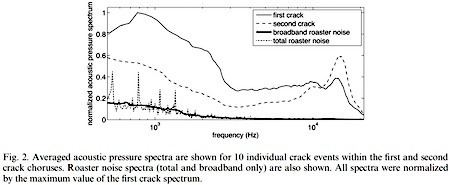
Here is someone else’s recording of the first crack and second crack:
BONUS: The sound of Rice Krispies in milk (historic recording):
BONUS (of interest only to specialists): Video of the sound of Rice Krispies when insufficient milk is added to them:

May 20, 2014
Flirting versus coquetry: The film about the debate
Filmmaker Julian Petschek contributes, Wikipedianly, to the academic debate about flirting versus coquetry:
BONUS: The iconic books Flirting: Webster’s Quotations, Facts and Phrases and Coquetry: Webster’s Timeline History, 1738 – 2006, both written by the computer program written by Philip M. Parker, who, at our last report, had reportedly written 1,050,000 books.

Quarreling over the ethics of anti-love biotechnology
The ethics of anti-love biotechnology — a topic little discussed in some circles — are chewed over in a special issue (volume 13, issue 11, 2013) of the American Journal of Bioethics.
Among the articles there that you might love to read or not to read:
The Difficult Case of Voluntariness as Autonomy in Anti-Love Biotechnology
If I Could Just Stop Loving You: Anti-Love Biotechnology and the Ethics of a Chemical Breakup
Anti-Love Biotechnologies: Integrating Considerations of the Social
Anti-Love Biotechnology: Was It Not Better to Have Loved and Lost Than Never to Have Loved at All?
A Thomistic Account of Anti-Love Biotechnology
Involuntary Exposures to Love-Enhancing or Anti-Love Agents
Maia Szalavitz writes about an underlying question — “Is It Possible to Create an Anti-Love Drug?” — in New York Magazine.
BONUS: Here’s video of a now-possibly-controversial song by The Beatles, called “All You Need Is Love“:
BONUS: A difficult case for bioethicists — Connie Smith’s “I Never Once Stopped Loving You”

Marc Abrahams's Blog
- Marc Abrahams's profile
- 14 followers


